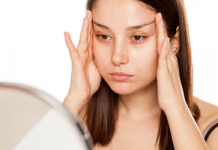What is known as “aura” is a disorder of a sensory nature which may precede the onset of a migraine. It means that people begin to observe colorful spots, broken lines, or bright flashes before a headache. But auras can occur even if not followed by a headache. This condition is referred to as “acephalgic migraine” or, more recently, “silent migraine.” A small number of sufferers can get aura but no pain. If not accompanied by pains, migraine aura is all but indistinguishable from other types of visual disorders. Actually, it is a fairly rare occurrence.
What is an aura?
To give aura its formal definition, it is a repetitive manifestation of various passing sensory, visual and vocal symptoms. Such a manifestation precedes an onset of a headache, but if it doesn’t happen, it should be treated differently. The aura symptoms are subject to growth and change.
Aura is regarded as a migraine precursor on par with other signs, for instance, nausea or sharp reactions to sound and light. Aura is generally episodic and apt to pass away by itself in five or ten minutes. But in some cases, it can last for about an hour!
How common is aura among migraine patients?
As the American Migraine Foundation gives away, aura occurs in every third or fourth migraine sufferer. It can be over in a matter of minutes or go on for an hour; sometimes, when it lets up no headache is experienced.
Stages of a migraine
Migraine is commonly broken down into four stages: prodromal stage, aura, onset and post-drome; therefore, aura constitutes its second stage. It follows the prodromal stage during which some foretokening signs can be noticed even up to two days prior to the actual attack.
Foretokening signs generally embrace sudden mood shifts, stiff neck, craving for a particular food, uncontrollable yawning and urination. As the onset comes to an end, the post-drome stage succeeds during which people feel spent, confused and fazed for the following day. However, it doesn’t mean that all these stages will necessarily be played out.
Symptoms of silent migraine
Silent migraine/aura can reveal itself differently depending on a particular individual, but most commonly, you may experience the following:
Visual delusions
Migraine aura almost always produces visual delusions – they take place in 98–99% of cases. An afflicted individual usually sees things like:
- various spots, sometimes colored, sometimes not
- flashes, shimmering lights
- jaggy, zigzag lines
- blurry shapes as if seen through a thick fog
- Besides, visual aura may limit the field of vision and produce blind spots for a while.
Sensory experiences
Aura also brings on some uncommon sensory experiences medically referred to as paresthesias. They are often simultaneous with visual images and express themselves through:
- tingling sensations; limbs go numb
- the needles-and-pins effect
- noises that can’t be real
Speaking/language impediments
Problems with speaking and arranging words are registered in 10% of people with migraine aura. They slur over their words, lose the possibility to form words and speak inarticulately.
It should be mentioned that silent migraine could strongly resemble the symptoms of an oncoming stroke. Should you notice any of the signs cited below, consult a doctor immediately:
- sudden sensory phenomena appear that are not natural
- when aura overruns an hour or traces of it still remain
- one side of the body feels abnormally weak
- you are absolutely confused or even lose consciousness.
Migraine treatment tips
Untreated migraines overcome their victims for a period of several hours but can last up to several days. There are medications that can make migraines go away or prevent them if taken in good time. You will find the one that helps you with your doctor.
But just taking medicine is not enough, make sure you follow up on the treatment. Don’t miss your checks and appointments, when your condition gets worse, consult your physician or call the nurse advice line. Write down what medication you take and how it makes you feel.
How can you care for yourself at home?

After you took a prescribed pain pill, avoid driving a car.
If you feel attacked by a headache or an aura, adjourn to a dark silent room, relax and avoid straining your eyes. Spend some time there with closed eyes until you feel better.
When a headache comes on, press a moist cloth over the area where the pain is strongest, insert a thin cloth between it and your skin, and hold it in place for about 10 minutes or more if necessary.
If your neck and upper back muscles don’t want to relax, help them by covering with a heating pad in a low mode or a towel moistened in warm water.
Get your family member to give a soft massage to your neck muscles.
Make a point of taking the prescribed medicines only at specified time periods. If you have doubts about your current treatment, consult a doctor or the nurse advice line.
Pills for headaches shouldn’t be taken very frequently. If you have got a long headache and go on taking medication for three days a week and more, you can make your pain worse because too many painkillers can cause headaches too. They are known as “medicine-overuse headaches.” You should go and see your doctor.
Migraine prevention measures
Register your auras and migraines in a diary – it will help you understand what factors serve to bring them about. As soon as you have pinpointed them, you will be able to prevent the attacks. Put down the time when a migraine or an aura started, their duration and accompanying symptoms. Maybe there are some extra symptoms.
Do you have medication prescribed for your migraines? As soon as you feel an onset of an aura, take it (or take it at the point when your doctor instructed you to).
Avoid stressful situations or learn to cope with stress – stress is a frequent cause of migraines. Therefore, mindful attitude to life and pranayama, or yoga breathing exercises, can alleviate the onsets.
You must have sufficient sleep. Exercises are a great help unless you push yourself – if you indulge in hard exercising, it can bring on an attack.
Make sure you have regular meals. By this time you should know what dishes and drinks can trigger headaches – naturally, it is alcohol, port and red wine more than other kinds, and chocolate. As for other foods, be on the lookout for food chemicals – aspartame, monosodium glutamate (MSG), and some others are well-known migraine triggers. The same goes for food additives, many of which are used in pickled foods, hot dogs, aged cheeses, cold cuts, and bacon.
Watch out for your caffeine intake by carefully dosing coffee, tea, soda, and certain other beverages. Mind you go off caffeine gradually since an abrupt stoppage can also bring headaches.
Cut off on smoking and stay away from smokers.
For those on birth control pills or undertake hormone therapy, it is advisable to ask your physician whether it can be conducive to migraine onsets.











